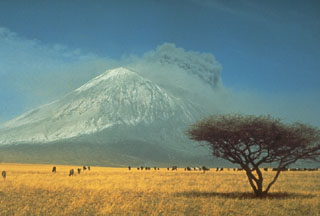Report on Ol Doinyo Lengai (Tanzania) — September 1994
Bulletin of the Global Volcanism Network, vol. 19, no. 9 (September 1994)
Managing Editor: Edward Venzke.
Ol Doinyo Lengai (Tanzania) New active hornito and central depression
Please cite this report as:
Global Volcanism Program, 1994. Report on Ol Doinyo Lengai (Tanzania) (Venzke, E., ed.). Bulletin of the Global Volcanism Network, 19:9. Smithsonian Institution. https://doi.org/10.5479/si.GVP.BGVN199409-222120
Ol Doinyo Lengai
Tanzania
2.764°S, 35.914°E; summit elev. 2962 m
All times are local (unless otherwise noted)
A small eruption on 18 September 1994 was the first observed activity since July 1993. A new central depression ~20 m deep was emanating hot gas from a prominent ring fracture ~100 m in diameter. Virtually continuous booming and rushing noises indicated near-surface lava, but it was not possible to see over the dangerous overhang. The new depression within the existing crater overlapped the 1992-93 eruptive sites and caused partial subsidence of older hornitos. A separate new lava-filled central hornito (~30 m in diameter and 10 m high) was observed for ~6 hours. Highly vesicular brown lava erupted once to the brim and was sampled. Lava was generally a few meters below the surface of the hornito, but periodic surges ejected spatter to ~30 m away. These ejections were interspersed with jetting of colorless gas and occasional widespread lapilli emissions to ~50 m away. The new hornito lava, ~50 m above the base of the central depression, was very frothy, crystal-rich, non-incandescent, and appeared similar to the type seen in 1992.
Geological Summary. The symmetrical Ol Doinyo Lengai is the only volcano known to have erupted carbonatite tephras and lavas in historical time. The prominent stratovolcano, known to the Maasai as "The Mountain of God," rises abruptly above the broad plain south of Lake Natron in the Gregory Rift Valley. The cone-building stage ended about 15,000 years ago and was followed by periodic ejection of natrocarbonatitic and nephelinite tephra during the Holocene. Historical eruptions have consisted of smaller tephra ejections and emission of numerous natrocarbonatitic lava flows on the floor of the summit crater and occasionally down the upper flanks. The depth and morphology of the northern crater have changed dramatically during the course of historical eruptions, ranging from steep crater walls about 200 m deep in the mid-20th century to shallow platforms mostly filling the crater. Long-term lava effusion in the summit crater beginning in 1983 had by the turn of the century mostly filled the northern crater; by late 1998 lava had begun overflowing the crater rim.
Information Contacts: A. Jones, W. Taylor, A. Church, L. Johnson, and T. Allison, Univ College London.

